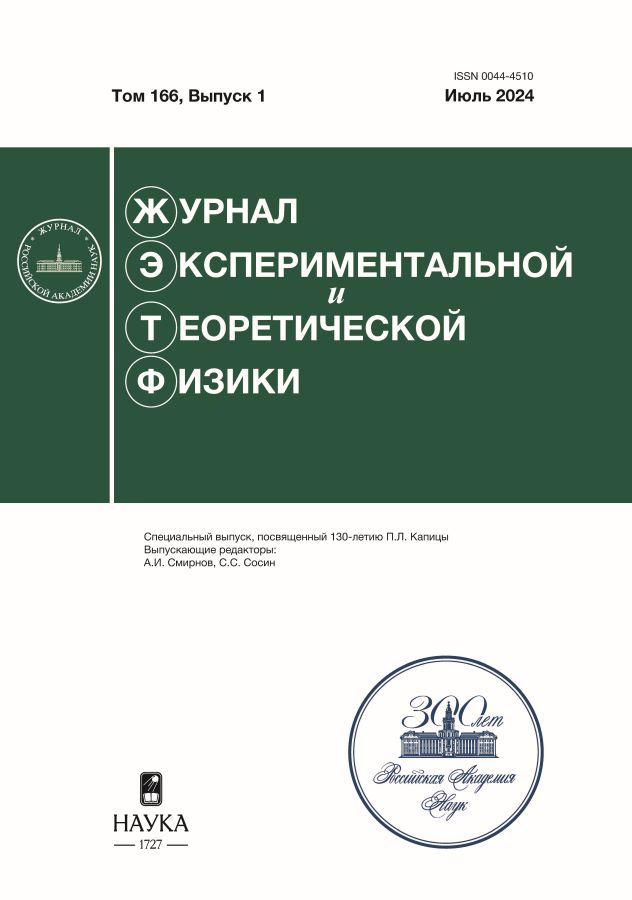ON THE MICROSCOPIC APPROACH TO THE ANDREEV CURRENT...
- Autores: Arseev P.I.1, Maslova N.S.2, Bilinskii Y.M.1
-
Afiliações:
- P.N. Lebedev Physical Institute of the Russian Academy of Sciences
- M.V. Lomonosov Moscow State University
- Edição: Volume 166, Nº 1 (2024)
- Páginas: 38-44
- Seção: Articles
- URL: https://rjeid.com/0044-4510/article/view/653852
- DOI: https://doi.org/10.31857/S0044451024070058
- ID: 653852
Citar
Texto integral
Resumo
It was shown how we can describe microscopically the Andreev current in a uniform way for a contact with direct coupling between N and S leads and with intermediate chain of atoms (multilayer system) inside the contact. Considering various types of connection of the normal lead to external thermal bath we reproduce various nonequilibrium distributions at the edge of the normal lead. It was shown what type of connection to the external reservoir corresponds to the classical result of Blonder,Klapwijk and Tinkham. Also we discuss difference in equilibrium and non equilibrium proximity effect, and it is clarified that the Andreev current arises due to the nonequilibrium effects which is much larger than the equilibrium one. Contribution for the JETP special issue in honor of P. L. Kapitza’s 130th anniversary
Sobre autores
P. Arseev
P.N. Lebedev Physical Institute of the Russian Academy of Sciences
Email: ars@td.lpi.ru
Moscow, Russia
N. Maslova
M.V. Lomonosov Moscow State UniversityMoscow, Russia
Yu. Bilinskii
P.N. Lebedev Physical Institute of the Russian Academy of SciencesMoscow, Russia
Bibliografia
- K. K. Likharev, Rev. Mod. Phys. 51, 101 (1979).
- A. F. Andreev, Zh. Ekps. Teor. Fiz. 46, 1823 (1964) [Sov. Phys. JETP 19, 1228 (1964)]; Zh. Ekps. Teor. Fiz. 49, 655 (1966) [Sov. Phys. JETP 22, 455 (1966)].
- G. E. Blonder, M. Tinkham, and T. M. Klapwijk, Phys. Rev. B 25, 4515 (1982).
- L. V. Keldysh, Sov. Phys. JETP 20 , 1018 (1964).
- C. Caroli, R. Combescot, P. Nozieres et al., J. Phys. C: Solid State Phys. 4, 916 (1971).
- K. D. Usadel, Phys. Rev. Lett. 25, 507 (1970).
- J. C. Cuevas and M. Fogelstrom, Phys. Rev. B 64, 104502 (2001).
- S. Gueron, H. Pothier, N. O. Birge et al., Phys. Rev. Lett. 77, 3025 (1996); N. Moussy, H. Courtois, and B. Pannetier, Europhys. Lett. 55, 861 (2001); H. Courtois, P. Charlat, Ph. Gandit et al., J. Low Temp. Phys. 116, 187 (1999); P. Dubos, H. Courtois, B. Pannetier et al., Phys. Rev. B 63, 064502 (2001).
- C. Cuevas, A. Martin-Rodero, and A. Levy-Yeyati, Phys. Rev. B 54, 7366 (1996).
- N.S.Maslova, P.I.Arseyev, Sol.St.Comm.,108, 717, (1998).
- P.I.Arseev,S.O. Loiko, N.K. Fedorov, Uspekhi Fizicheskikh Nauk, 176, 3 (2006) [Physics–Uspekhi 4 9 (1) (2006)]
Arquivos suplementares










